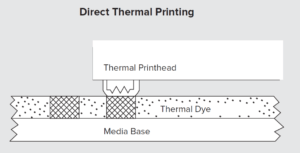Label Printing
Choosing the correct label printer for your application is the first step.
Some questions to consider..
- Label sizes to be printed?
- Labels required per day/shift?
- Environment for label use?
- Monochrome or Colour?
- Printer connectivity options?
- Support and Service options?
- Printer use environment?
- Mobile or fixed location?
- Ease of operator use?
- Ease of operator maintenance?
Label Printers – Basic Concepts
Direct Thermal
Schematic

Description
Direct thermal involves the heating of a specially coated paper, label or tag which produces the print image. This is carried out by a printhead which is directly in contact with the surface of the material
Advantages
- Direct thermal printing produces sharp print quality with good scannability.
- Direct thermal is ideal for applications requiring only a short shelf life — meaning the label image does not need to last very long. Shipping labels and receipts are ideal applications, for instance, while product labels are not.
- Direct thermal printers are simple to operate compared to most other print technologies because there is no ink, toner or ribbon to monitor or replenish.
- With no supplies to replace other than the material to be printed, long-term maintenance costs remain low.
- Direct thermal enables batch or single label printing with virtually no waste.
- With recyclable materials available, direct thermal printers offer environmental economy.
Limitations
- Direct thermal printing is extremely sensitive to environmental conditions such as heat and light (fluorescent and / or direct sunlight).
- Direct thermal paper remains chemically active after printing. Because of this, thermal labels, tags or ticket stock are often top coated to resist UV light exposure, chemicals and abrasion.
Thermal Transfer
Schematic

Description
Thermal transfer printed labels are easily identified by the crisp, often glossy, printed surface. The clarity is achieved by using a thin ribbon roll that when heated by the printhead melts onto the label to form the image. The ink is absorbed so that the image becomes part of the media.
Advantages
- Thermal transfer delivers crisp, high-definition text, graphic and barcode print quality for maximum readability and scannability.
- Thermal transfer printing produces long-life image stability.
- Thermal transfer enables batch or single label printing with virtually no waste.
- Long-term maintenance costs are low compared to dot matrix, ink jet and laser printing.
- Thermal transfer technology can print on a nearly unlimited variety of media stock (except multi-form).
Limitations
- Since thermal transfer printers require ribbon, supply costs are higher than direct thermal; however, thermal transfer printheads last longer than direct thermal printheads.
- Single-pass thermal transfer ribbon can be wasteful if little is printed on it.
- Thermal transfer ribbon is a poor candidate for recycling.
- To obtain optimum print quality in thermal transfer printing, the ribbon and media substrate MUST be compatible. Otherwise, the heat from the printhead could melt the ribbon onto the label causing internal printer problems.
Colour Inkjet
Schematic

Description
Piezoelectric printing uses a printhead that has a piezoelectric material at the back of the ink chamber for each nozzle. An electric current is passed through the piezoelectric material, which causes the material to deform. As the material changes shape, the space in the ink reservoir is reduced and ink is forced out of the nozzle. When the pulse of current passes, the piezoelectric material returns to its original shape, creating a vacuum and pulling ink from the ink reservoir to replace the ink that has been expelled from the chamber.
Advantages
- High print quality
- Full colour
- Reduces need for pre-printed label stock
- Print one to many full colour labels
- Create “proof of concept”, product launches or complete production runs
- Fast
- Flexible
Limitations
- Specialised label stock required
- Sometimes more expensive than traditional flexo printers for large print runs
For more information click on the images below to see our printer portfolios
Label Printing
Our team of label printing specialists are available to assist you in the correct choice for your application.
Contact Us






